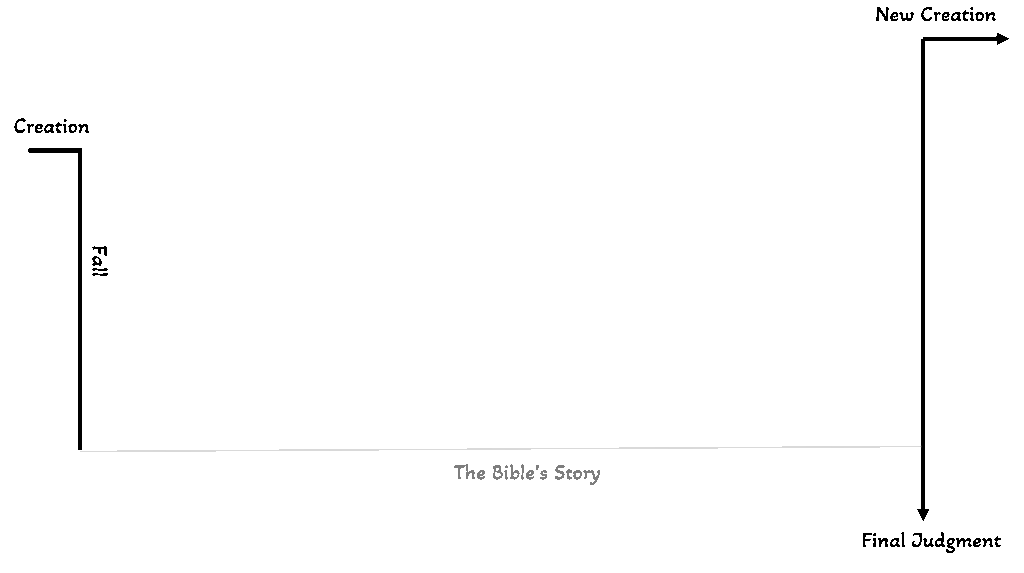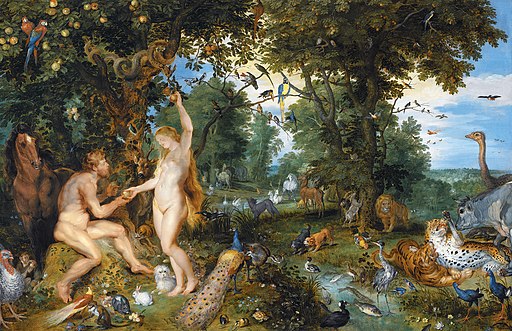How does the Bible begin? While the first several chapters can be analyzed in a number of ways, they serve to establish the premise and nature of human existence. These chapters setup the story: the principle protagonists, antagonists, and the problem. It is a long story, however, and the playwright continues his daily work, encompassing ourselves as the current cohort of actors, entering the stage and playing our brief parts. And, just like any play or book, the author has provided the audience with hints and pointers at how these intractable problems might be alleviated — even providing peaks at the ending.
We are getting ahead of ourselves. The story of the Bible begins in Genesis, the first book in the Old Testament. It is also the first of the grouping of the ‘Law’ or ‘Torah’, the first five books of the Bible, which have been traditionally attributed to Moses. It is in their text that we find the Flood, the Call of Abram/Abraham, the Twelve Tribes, the Plagues of Egypt, the Exodus, the giving of the Law (including the Ten Commandments), and the preparation to enter the Promised Land. We will spend some time teasing apart these individual narratives and consider why they were incorporated into the wider text. For now, we can turn to Genesis 1.
Start by reading Genesis 1.1-8 (if the passage is familiar) or 1.1-25 if you haven’t visited it in a while. While reading, consider how this passage characterizes God, and how it describes Creation. I’ll wait.
God brings into existence Form and Order from the prior chaos. He creates and organizes the world, observing tha everything was ‘good’. God had made a good Creation that brought order, structure, and life of all kinds. It is on the sixth day, however, that we at last reach the climax of Creation, which we can read in 1.26-2.3. In reading this passage, consider how ‘Man’ is different and uniquely described and what his role is. (Note that the word ‘Man’ is generic for ‘person’ or ‘human’, and at this stage probably represents both sexes.)
What is different about the creation of Man? Man was created after God’s image and likeness, and set to rule justly over the rest of Creation. Rather than servants or slaves as in many other contemporary creation accounts, Man is to be an image — a living, breathing statue or idol placed in God’s temple of Creation. They are to be fruitful and multiply (we also saw this of all animals in 1.22), filling the ‘good’ earth. And at the end of the Creation of Man, God reflected that it was ‘very good’. So much so that God ‘rested’ on the seventh day: the Creation was finished. The entire seven-day period may reflect language of a Near East temple dedication which could take seven days: six days for the rituals and consecrations, and a seventh day when the god would take up residence.
Genesis 2 provides a separate account which focuses on Man: Man’s roles, and the importance of relationship as that ‘Man’ is divided into male and female. They are given complete freedom, with a single condition: to not eat the fruit of the knowledge of Good and Evil. While there was certainly some work to be accomplished, the man and woman had access to rest, abundance, and relationship with one another and with God. It did not, however, take long for the seeds of discontent to be planted in their minds and hearts. Their thoughts were on this forbidden tree when the ‘crafty serpent’ approached. The creature is the tempter, voicing their own internal struggle.
We can now read Genesis 3.3-13, considering what is at the heart of this Sin.
The Sins of the man and the woman were decisions to disobey God, but the disobedience had side effects, including Shame. The chapter finishes by describing the state of the world as it is impacted by Sin — this Fall of Man from his position of ruler and image-bearer of God was destroyed also effected the rest of the world. Pain and Death were introduced. Labor (at plow and childbirth) would be painful. They were expelled from the garden as the rebellious citizens of God’s country — their wickedness must first be dealt with. The manifestation of Man’s wickedness was often thought to have taken but a few hours (see, e.g., Sanhedrin 38b which suggests a single hour in the garden before their sin). Their state was such that they could no longer dwell with God, but God did not abandon them to their own pitiful fates. Instead, he dressed them in animal skins to cover their Shame, and set in motion a ‘rescue mission’ to restore the broken relationship between Man and God.
We can see the promised destination of this ‘rescue mission’ by reading Revelation 21 and 22. While Revelation has been a text that has (in some traditions) been the source of wild speculation and calculation, it is largely a narrative that draws on ‘apocalyptic’ imagery from Old Testament prophets (e.g., Daniel, Ezekiel, Isaiah, Zechariah), Jewish apocalyptic literature (e.g., the Book of Enoch), early Christian symbolism (e.g., dragon as snake from the garden/satan), and imagery from the wider eastern Mediterranean context. We won’t dwell on these particulars in the present study, but focus on the Revelation readings with thoughts to how this ‘end’ (well, ‘new beginning’ may be more appropriate) undoes the problems introduced in the Fall.
What does Revelation 21.1-5 present in relation to Genesis 1-3? We have the presentation of New Creation, one not tarnished by the Fall. We see the end of Pain and of Death — the consequences for the man and woman of the Fall. And, the ultimate restoration: God coming to dwell with Man. Revelation 22.1-4 restores the garden imagery, with fruit, healing, and nothing accursed.
Revelation 21-22 look forward to ‘New Creation’ — an eventuality that we too look forward to as well. The restoration of the ‘very good’ state that God established in Genesis 1-2.3, where God can live and walk with the pinnacle of his creation: Man. Pain, suffering, and Death are eliminated. But, how exactly will the promised future of Revelation 21-22 be brought about? This, in fact, is the question this study seeks to answer. By examining Genesis 4 through Revelation 20 (the ‘middle’ of the Bible), we will be able to see the united narrative which the prophets and New Testament writers understood. They (like us) looked forward to the restoration of all things, the making of all things new in Revelation 21-22. In this larger story, we will watch God reach out to individual human beings (his chosen instruments to act in the world) in his search to restore the relationship of Man and God.
How can this aid us in understanding the world as it is today? We are in a fallen world which needs restoration, and so we see the Pain, Toil, and Death all around. Yet we also have a promise that this will be restored. There is another idea lurking here that describes how we should treat other people, recognizing that everyone is an image-bearer of God (however besmirched), and God desires all to be reconciled to himself (i.e., a relationship with them). And, it is reminiscent of C. S. Lewis’ discussion in the Weight of Glory:
It is a serious thing, to live in a society of possible gods and goddesses, to remember that the dullest and most uninteresting person you talk to may one day be a creature which, if you saw it now, you would be strongly tempted to worship, or else a horror and a corruption such as you now meet, if at all, only in a nightmare. All day long we are, in some degree, helping each other to one or another of those destinations.
The workbook this study is derived from included a diagram, which I have recreated here (and will recreate, with some basic modifications, in future lessons). This schematic will be filled in as we explore the Story of the Bible. The vertical (y-axis) shows the ‘goodness’ of Man’s experience. The horizontal (i.e., x-axis) shows time, proceeding from left (Creation) to right (New Creation). The solid line represents Man’s current experience at a particular point in time. As we read the Bible, we’ll also introduce a dotted line which represents the ‘goodness’ of what God is promising through covenants and prophets.

Bible’s Story Diagram. The ‘y-axis’ (i.e., vertical direction) indicates the good-ness of the world. The solid line shows the good-ness as experienced by humans. Thus, in Genesis 1, we have Creation which God declares to be ‘good’ (or ‘very good’). After the Fall, humans are expelled from Eden. Their experience of the good-ness of the world is diminished: it is difficult. The ‘x-axis’ (i.e., horizontal direction) indicates time. We therefore begin with the beginning (Creation) and continue until God makes all things new (i.e., New Creation). In between is the Story of the Bible which demonstrates how God will restore people and provide them with a glorious inheritance.
